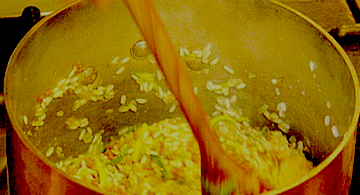
Leftovers never tasted better than when made into Baked Vegetable Tetrazzini, a delectable variation of the quintessential classic tetrazzini. If you're making it post-holiday, be sure to include cooked vegetables, roasted chestnuts…whatever you have leftover from your holiday table along with fresh mushrooms and other seasonal produce. If it tastes good with pasta and cream sauce, it will taste great in tetrazzini! For a smoky note, add a handful of chopped lightly smoked baked ham.
On your next grocery shopping trip, look for specialty pasta made with chestnut flour, porcini powder, or crushed black pepper, for it adds such an interesting richness to this dish. A flat cut of pasta, such as tagliatelle or fettuccine, even curly egg noodles, makes a much better dish than dried-out spaghetti strings. The flat cuts hold the creamy sauce and provide a bed for savory vegetables. A lot of effort goes into making a good tetrazzini, so why not take a little extra time and read the information below? Since I cannot be in your kitchen with you, imagine we're having a conversation now filled with good cooking tips. I want you to carry your Baked Vegetable Tetrazzini casserole to the dining table and present it with as much pride as you presented your Holiday Roast.
Do not be put off by the long explanation; it is here to guide you so your tetrazzini is the best it can be. Many versions are sticky masses but not this one. For your convenience, amounts are written for quantity or weight, as well as volume, if you do not have a scale or prefer using measuring cups. Tetrazzini should be Silken, Supple, Luscious.
Formula for one 9-inch x 13-inch x 2-inch (23-cm x 33-cm x 5-cm) baking dish: 12 cups (2.84 liters) volume tetrazzini mixture.
6 cups (1.42 liters) volume solids + 6 cups (1.42 liters) volume sauce + 1 cup (237 ml) volume grated/diced/shredded cheese + 6 cups (1.42 liters) volume boiled flat-cut pasta = 12 cups (2.84 liters) volume tetrazzini mixture. Following this formula and techniques written below, the finished tetrazzini should be very moist, creamy, and luscious.
6 to 8 servings. Sauteing time is 10 to 15 minutes, boiling pasta is 5 to 7 minutes. Baking time is 45 to 50 minutes in a preheated oven at 375 F/190 C/Gas Mark 5. Allow to set for 5 minutes before plating. Quantities are for one 9-inch x 13-inch x 2-inch (23-cm x 33-cm x 5-cm) baking dish, adjust as needed for a different size baking dish.
Tetrazzini: Becomes 6 cups (1.42 liters) volume solids after cooking
1 tablespoon (15 ml) sunflower, safflower or grapeseed oil
1 medium leek, white part to light green, thinly sliced
1 peeled whole garlic clove, to be removed or finely chopped if included
10 ounces (283 g) sliced fresh mushrooms (3 1/2 cups or 828 ml volume raw slices)
Fresh porcini, thawed frozen porcini, or reconstituted dried porcini, optional
Salt to taste
1/2 cup (4 ounces or 118 ml) white wine
Fresh thyme leaves (or marjoram or tarragon leaves)
12 ounces (340 g) white cauliflower florets, blanched for 2 minutes (2 cups or 473 ml volume florets)
5 ounces (142 g) fresh green peas, blanched (1 cup or 237 ml volume)
OR 4 medium (4 ounces or 113 g) fresh asparagus spears, trimmed, diagonally sliced pieces (1 cup or 237 ml volume pieces)
OR cooked green string beans (1 cup or 237 ml volume)
2 ounces (57 g) shredded raw carrots (1 cup or 237 ml volume)
Sauce: Makes 6 cups (1.42 liters) volume of sauce
4 ounces (113 g) unsalted butter
2 ounces (57 g ) “00" or all-purpose flour (use about 5 tablespoons)
1 cup (8 ounces or 237 ml) chicken broth
3 cups (24 ounces or 710 ml) whole cow’s milk, warmed
1 cup (8 ounces or 237 ml) heavy cream
Salt to taste
Freshly grated nutmeg to taste
OR Grated zest from 2 small lemons
Dry mustard to taste, optional
1 cup (8 ounces or 237 ml) sour cream – add when sauce has cooled down – is really good
Salt to taste
Cheese: 1 cup (237 ml) volume cheese
2 ounces (57 g) aged 3-6 months Asiago or Montasio cheese (1/2 cup or 118 ml volume, diced or grated)
2 ounces (57 g) aged 24 months Parmigiano-Reggiano cheese (1/2 cup or 118 ml, grated)
Salt to taste
Pasta: 6 cups boiled tagliatelle or fettuccine
12 ounces (340 g) chestnut, or porcini, or black pepper, or classic egg tagliatelle or fettuccine
Topping – Baking:
1 1/2 tablespoons (0.75 ounce or 21 g) unsalted butter, cut into small cubes
Topping – Plating:
Freshly grated zest from 1 medium lemon
Fresh coarsely ground black pepper
Tetrazzini Preparations: Peas or Asparagus, Cauliflower: If using pre-cooked vegetables, omit this step.
Peas or Asparagus: Bring lightly salted water to a rolling boil. Immerse the peas and blanch for about 1 minute – or – Immerse the asparagus pieces and blanch for 1 to 2 minutes.
Cauliflower: Immerse cauliflower florets and blanch for 2 minutes.
Remove. Drain, then put under cold running water to stop cooking. Drain well. Reserve.
Sauteing Tetrazzini Mixture: In a non-stick pan, warm the oil over low-medium heat. Add the sliced leeks and whole or chopped garlic and saute until the leeks soften and are cooked halfway but not browned, about 3 minutes. Add the sliced fresh mushrooms. Season with salt to taste to extract their juice and stir well. Saute for a few minutes until the juices are drawn out and the mushrooms soften and become fragrant. (Optional: Add the thawed porcini cubes, saute for 1 to 2 minutes.) Increase the heat to high, pour in the white wine. Deglaze for a few minutes without stirring until the wine reduces by more than half volume. Stir in the fresh herbs. Remove from the heat. Remove the whole garlic clove if included. Cool mixture a little.
Making the Sauce:
1. In two different pots over low heat, warm the broth and warm the milk for a few minutes until almost steaming, remove from the heat and reserve. Meanwhile, in a different deep, non-stick pot over low heat, melt the butter and stir in the flour with a whisk or heat-resistant spatula until they combine into a smooth thick paste. Continue to stir and cook the butter-flour mixture for about 1 minute without browning.
Ladle in the warm broth, whisking continuously to prevent lumps, until creamy smooth, about 30 seconds. Then, pour in the warm milk, one or two ladles at a time, incorporating the milk with the roux by whisking continuously to prevent lumps, then repeat with the next ladle of milk. At first, it looks like smooth potato purée, and adding more milk, it thins out and looks like heavy cream.
2. Increase the heat to medium. Continue heating for 4 to 5 minutes, stirring and scraping the bottom and sides of the pot with a heat-resistant spatula since flour tends to settle on the pot. Bring the sauce to a boil. As the flour thickens, the sauce looks similar to buttermilk. This actually makes it light in texture and removes the raw flour taste. Remove from the heat. Pour through a fine strainer to catch any small lumps. While warm, taste and add more salt if needed.
3. Cool the sauce to room temperature before adding it with the other ingredients. Season with optional flavoring of freshly grated nutmeg or grated lemon zest, and/or dry mustard if you wish. As this sauce cools, a thin skin forms on the surface. Simply pick it up with a fork and discard. Alternatively, dot the surface with tiny bits of butter, which melt and prevent the skin from forming – OR – press cling wrap directly onto its surface, and this prevents any skin from forming. (If making in advance, cool completely, cover and refrigerate up to 2 days before using. Remove from refrigeration about 30 minutes before tossing with the other ingredients.)
Add 1 cup (237 ml) sour cream and stir into the cool sauce before adding to the mixture.
Boiling the Pasta: In a deep pot, bring lightly salted water to a rolling boil. Add the pasta, stirring occasionally to prevent the pasta from sticking together. Boil the pasta until firm al dènte, because it continues cooking with the other ingredients when baked in the oven. Drain. Run cold water over the pasta to stop the cooking, drain well.
Prepare the Baking Dish and Preheat the Oven to 375 F/ 190 C/ Gas Mark 5: Liberally oil or butter the interior of the baking dish. Cut the butter into small cubes for topping.
Mixing Ingredients in a Broad Bowl: Even mixing the tetrazzini components is better when following this method: If using a deep narrow bowl, the sauce goes to the bottom. So use a broad bowl. Keep picking up the mixture with tongs and turning it over while filling the baking dish.
Put the sauteed mixture of leeks, mushrooms, and porcini if including, in the mixing bowl. Add the drained blanched peas or asparagus or cooked green string beans, cauliflower, and shredded raw carrots. (If including, add chopped smoked ham now.) Add the sauce, Parmigiano-Reggiano, and Asiago. Toss until all ingredients are thoroughly coated. Add the drained boiled pasta and toss until all ingredients are thoroughly coated – and the mixture is very sloshy* – you will hear the slosh. (* Very important because ingredients absorb much liquid during baking. If the mixture is dry before baking, it will be really dry after baking, so keep it sloshy.)
Baking Tetrazzini: Preheat the oven to 375 F/ 190 C/ Gas Mark 5.
1. Add the tetrazzini mixture and level. On top, intermittently place the butter cubes about every 1 1/2 to 2-inches (3.81 to 5.08-cm).
2. Place in the center of the preheated oven. Bake for 40 minutes, turning around halfway after 20 minutes, for even baking. Check the surface. The tetrazzini along the baking dish’s edge rim should be bubbling, with a few light golden brown touches. The center of the tetrazzini, it should look moist, with a bit of sauce on top. Continue baking for another 5 or 10 minutes, then remove. The top center of the baked tetrazzini should look moist. (If the entire top looks golden brown and dry, it is definitely over-baked.)
3. Allow the tetrazzini to set for 5 minutes before serving so it is easier to plate and the pasta remains coated with sauce and vegetables, it retains heat well. (If served immediately from the baking pan, sometimes the sauce and vegetables drop to the bottom of the plate or bowl.) Optional: Garnish with freshly grated lemon zest and coarsely ground black pepper on top. Enjoy pure lusciousness!







